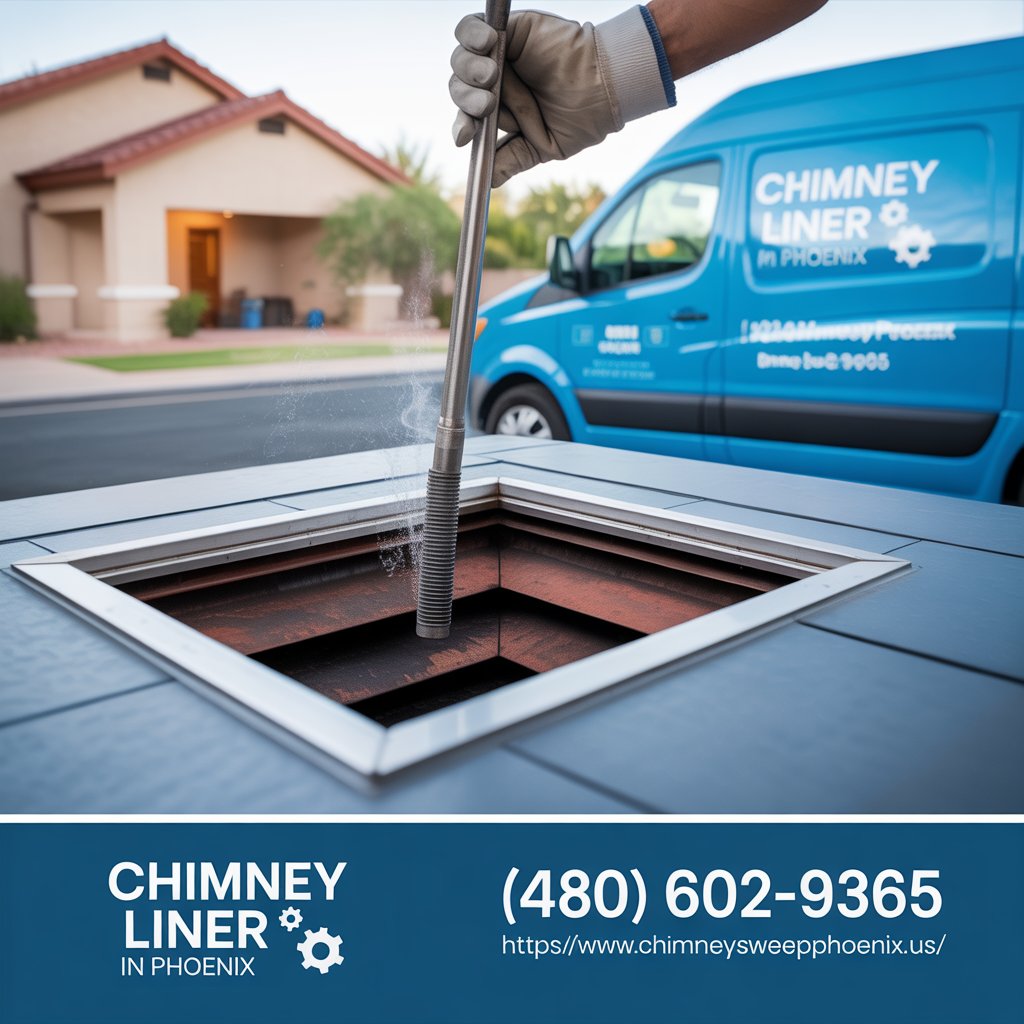If you’re a homeowner in Phoenix and you’ve recently been told your chimney liner needs to be replaced or installed, you might be wondering: What even is a chimney liner? Or maybe you’re asking yourself, How messy is this going to get? Don’t worry you’re not alone. Most people only deal with a chimney liner once or twice in their lifetime, and the process can seem more intimidating than it actually is.
In this guide, I’ll walk you through what really happens during a chimney liner installation, why it’s so important (especially in the dry desert climate of Phoenix), what it costs, and how to keep your home safe throughout the process. By the end, you’ll feel a lot more confident about what to expect when a pro shows up with tools and ladders in tow for your chimney liner in Phoenix.
So, What Is a Chimney Liner and Why Do You Need One?
Let’s start with the basics. A chimney liner is a tube or layer that lines the inside of your chimney flue. Its job is to protect your chimney walls from heat, corrosion, and toxic gases. It also improves the efficiency of your stove, fireplace, or furnace by helping the smoke and gases travel safely out of your home.
In Phoenix, where older adobe-style homes and modern builds exist side by side, many chimneys either don’t have liners or have aging clay liners that are cracked, crumbling, or totally missing in spots. That’s not just bad for efficiency—it’s a serious fire and health risk.
The Day of Installation: What Really Happens
A typical chimney liner installation takes about half a day to a full day, depending on the type of liner, the height of your chimney, and whether extra repairs are needed. Here’s a quick breakdown of what usually happens when the crew arrives:
1. Prep & Safety Check
The crew will start by laying down drop cloths and covering furniture near your fireplace. Expect some light dust and noise, but a good installer will keep things as clean as possible. They’ll also do a final inspection using a chimney camera to check for cracks, blockages, or loose mortar inside the flue.
2. Removing the Old or Damaged Liner
If there’s an existing clay liner that’s damaged, they’ll break it apart and remove it in chunks. This part can be noisy and messy but it’s totally necessary. Don’t worry, they’ll clean up the debris before moving on.
3. Inserting the New Liner
Most Phoenix homeowners opt for a stainless steel liner, which is durable, resistant to Arizona’s fluctuating temperatures, and approved for all fuel types. The crew will lower the liner down the chimney from the roof, sometimes insulating it to improve performance and safety.
4. Securing and Sealing
Once the liner is in place, they’ll attach it at both ends at the bottom to your appliance (fireplace, stove, etc.) and at the top to a rain cap or chimney crown. They’ll seal everything up with heat-resistant materials so no gases leak into your home.
5. Testing and Cleanup
Before they leave, the team will run a draft test to make sure smoke or exhaust exits smoothly. Then they’ll clean up the site and review everything with you.
Key Features of a Modern Chimney Liner
Here’s a quick table to help you see why modern liners are such a game-changer, especially in the Phoenix climate:
| Feature | Why It Matters in Phoenix |
| Stainless Steel Build | Handles extreme heat, rust-resistant in dry air |
| Insulation Option | Helps prevent creosote buildup in cold snaps |
| High Efficiency | Improves draft for gas and wood systems |
| Code Compliant | Meets national safety standards (NFPA 211) |
| Lifetime Warranty | Most liners come with a 10–25 year warranty |
What Will It Cost You in Phoenix?
You’re probably wondering how much this whole project will set you back. While the price can vary, most chimney liner installations in Phoenix range from $1,800 to $3,500 depending on:
- Height of your chimney
- Type of liner (flexible vs. rigid stainless steel)
- If insulation is added
- Access challenges (like steep roof angles)
- Condition of the existing flue
“Our liner install in Tempe cost around $2,400 total, but the peace of mind it gave us was worth every penny. Our tech explained every step, and the difference in fireplace performance was noticeable right away.” Rachel M., Phoenix homeowner
Some companies may offer free inspections or even financing plans, so don’t be afraid to ask. A good installer will be upfront with pricing before any work begins.
Safety First: Why You Shouldn’t Wait
A chimney without a functioning liner is like driving a car without brakes. It might seem okay for a while, but eventually, it’ll catch up with you sometimes in dangerous ways. Cracks in your flue can let carbon monoxide leak into your home or allow high temperatures to ignite nearby walls or insulation.
In a dry climate like Phoenix, where wildfire risks are already high and homes tend to be tightly sealed for HVAC efficiency, it’s extra important to have a well-maintained and lined chimney.
Some signs you may need a new liner:
- Strong smoky smell inside your home
- Cracks in the chimney masonry
- Fireplace isn’t drawing properly
- You recently switched to a new fuel source (like gas logs)
Even if you haven’t noticed issues, a yearly inspection is still a smart move. It’s the best way to catch small problems before they turn into major expenses or emergencies.
Wrapping It Up: A Worthwhile Upgrade
Getting a chimney liner installed isn’t just about checking a box on a to-do list. It’s a smart, safety-focused investment in your home. Whether you use your fireplace daily during those cool desert nights or only fire it up a few times a year, knowing it’s venting properly brings real peace of mind.
So if your technician says you need a new liner, don’t panic. Now you know what to expect, what questions to ask, and how the process works. Choose a licensed Phoenix chimney pro, get a solid quote, and let them handle the rest. With the right team, your fireplace will be back in top form in no time safer, cleaner, and more efficient than ever.
Read More: Chimney Sweep



